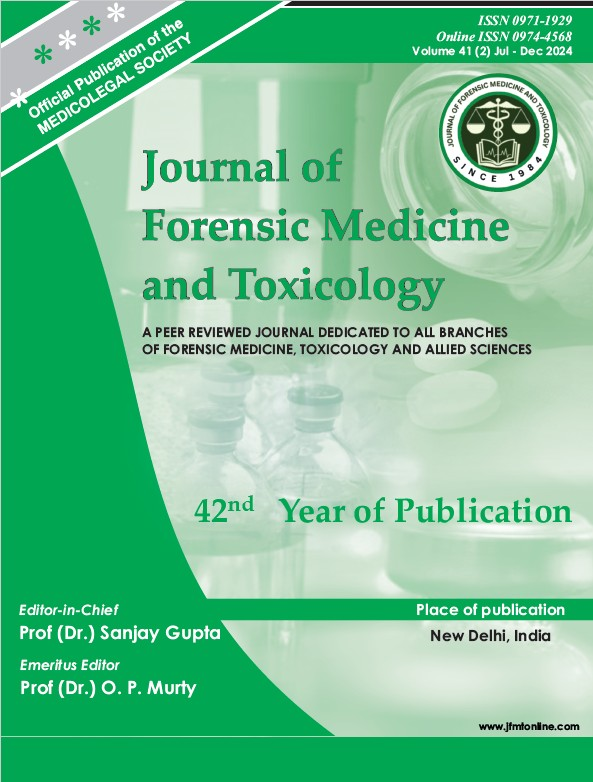A STUDY ON THE PREVALENCE AND PROGRESSION OF DENTAL ATTRITION AMONG YOUNG ADULTS
DOI:
https://doi.org/10.48165/jfmt.2024.41.2.16Keywords:
Age estimation, Teeth attrition, Teeth wear indices, Dental pathologyAbstract
The age of a person is an important characteristic that contributes to a person’s overall identity. With the growing age of a person, the incidence of tooth wear increases. It is irreversible and cumulative. Attrition means the loss of tooth substance as a result of tooth-to tooth contact. Grading tooth attrition can help as an additional tool in age estimation. We conducted this study to gauge the prevalence of dental attrition and its grading in young adults age groups in both genders. The present cross-sectional observational study was done in Srikakulam on 120 young adults, 60 male and 60 female, aged 18 to 25 years. We have modified Smith and Knight’s system and used it for our present study. Attrition of only the incisal and occlusal surfaces of teeth was studied. The data was analyzed using Fisher’s exact test. Results showed that in the studied teeth of incisors and first molars, the frequency of attrition teeth in males is 14% and in females is 18%. The lower incisors showed a greater incidence of attrition. A statistically significant correlation between age groups and attrition grade was seen in the lower incisors and lower molars of males and the upper first molars of females. So it was concluded that teeth attrition can be used as an additional tool in age estimation in young adults as well, but it can only give a wider age range.
Downloads
References
Pillay VV. Textbook of Forensic Medicine and Toxicology. 19th ed. Hyderabad: Paras Medical Publisher; 2019. Page 68
Hattab FN, Yassin OM. Etiology and diagnosis of tooth wear: a literature review and presentation of selected cases. Int J Prosthodont. 2000 Mar Apr;13(2):101-107
Ibiyemi O, Taiwo JO. Some socio-demographic attributes as covariates in tooth wear among males in a rural com-munity in Nigeria. Ethiop J Health Sci. 2012 Nov;22(3):189- 195
Hanif A, Rashid H, Nasim M. Tooth surface loss revisited: Classification, etiology, and management. Journal of Restor-ative Dentistry. 2015 May 1;3(2):37.
Grippo JO, Simring M, Schreiner S. Attrition, abrasion, corro-14. sion and abfraction revisited: a new perspective on tooth surface lesions. J Am Dent Assoc. 2004;135:1109-18.
Kaushik SK, Madan R, Gambhir A, Prasanth T. Aviation stress and dental attrition. Ind J Aerospace Med. 2009;53(1):6-10.
Acharya AB. A new digital approach for measuring dentin translucency in forensic age estimation. The American journal of forensic medicine and pathology. 2010 Jun 1;31(2):133-7.
López-Frías FJ, Castellanos-Cosano L, Martín González J, Llamas-Carre-ras JM, Segura-Egea JJ. Clinical measurement of tooth wear: Tooth Wear Indices. J Clin Exp Dent. 2012;4(1):e48-53.
Gustafson G. Age determinations on teeth. The Journal of the American Dental Association. 1950 Jul 1;41(1):45-54.
Smith BG, Knight JK. An index for measuring the wear of teeth. Br 16. Dent J. 1984;156:435-8.
Thippanna RK, Ramu VC. Preva-lence of Dental Attrition and its Severity in Relation to Age and Gender: A Clinical Study. CODS J Dent 2017;9(1):16- 21.
Liu B, Zhang M, Chen Y, Yao Y. Tooth wear in aging people: an investigation of the prevalence and the influential factors of incisal/occlusal tooth wear in northwest China. BMC oral health. 2014 Jun 5;14(1):1.
Jain R, Hegde MN. Dental Attrition-Aetiology, Diagnosis, and Treatment Planning: A Review. IOSR Journal of Dental and Medical Sciences (IOSR JDMS);1(14):60-66.
Yadav S. A Study on Prevalence of Dental Attrition and its Relation to Factors of Age, Gender and to the
Signs of TMJ Dysfunction. The Journal of Indian Prosthodontic Society. 2011 Jun 1;11(2):98-105.
Sangavi R, Saraswathi GK, Srividhya S. Structural Changes of Tooth, Root and Root Canal Morphometrics using Conebeam Computed Tomography for Assessment of Age in South Indian Population-ARetrospective Study. J Indian Acad Forensic Med. 2023 July-Sept 45 (3); Pg 255-260.
Hugoson A, Bergendal T, Ekfeldt A, Helkimo M. Prevalence and severity of incisal and occlusal tooth wear in an adult Swedish population. Acta Odontologica Scandinavica. 1988 Jan 1;46(5):255-265.
Pergamalian A, Rudy TE, Zaki HS, Greco CM. The association between wear facets, bruxism, and severity of facial pain in patients with temporo-mandibular disorders. The Journal of Prosthetic Dentistry. 2003 Aug 31;90(2):194-200.




